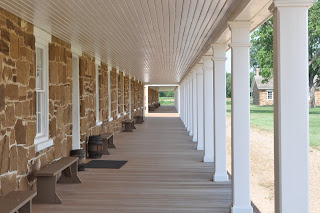Miles 469 (10,064)
Two Lanes 467 (7122) 71%
Top Down 443 (8188) 81%

Day 36
Emporia, Kansas. Home of the only university in America solely dedicated to creating teachers. You can choose from degrees like elementary education, middle school education, developmentally challenged education, school counseling and the like.
Our first stop today was a one of a kind: The Tallgrass Prairie National Preserve. The park preserves a few acres of the native prairie, of which only 4% remain. This prairie in 1850 was an oval shape and ran from Oklahoma through Kansas to Nebraska. This is the nutritious grass that fed the cattle drives. It lies in the Flint Hills of Kansas and is preserved only because in these hills the limestone is at the surface. It can’t be plowed and nothing but the natural grasses will grow.
We spent the day driving US 50 and 56 that follow the Santa Fe Trail. Along the way, we came to emergency vehicles and fire trucks and our lane was blocked, Linda yelled “Look, the train is on fire!” Sure enough, the firefighters were just finishing outing out a blaze in one of the locomotive engines. Now let me set the stage. There is natural gas in this part of Kansas. The locomotives were hooked up to about 50 tank cars being loaded with natural gas!! And the locomotive engine was on fire. I would have liked to hear that 911 call. I think the engineer must have seen his life pass before his eyes.
Driving west we passed through Lyons and Ellinwood, Kansas. These are near Cow Creek, just north of Hutchison. In a triangle bounded by these three towns, my grandfather was born in 1882. He left at age 17 in 1899 to join the US Army. After fighting in the Spanish-American War in the Philippines, he was discharged at the Oakland Army Terminal and stayed in California. Soon, all of his six siblings joined him.
I had found part of my roots.
Just a few miles south of Ellinwood on a dirt road, we stopped at Dozier Winery. This nice retired man makes wine from hybrid grapes that can take the Kansas winters, But sadly, his vines have died because of the drift from the herbicides used on the corn. He now brings his the grapes from other areas. The farmers used to grow wheat here, and did not us pesticides. But with ethanol, they have switched.
Think about this and the big picture.
Fort Larned and the Santa Fe Trail Center were the next stops. Prior to 1821, Spain owned Mexico, which included Arizona, New Mexico, and California. Spain strictly prohibited trade by Mexicans with the US. But in 1821 Mexico won their independence from Spain and opened up trade with the US. The Santa Fe Trail was born.
Santa Fe and Independence, MO at the Missouri River, were connected by a crude rough trail that roughly followed the Arkansas River for much of he way. This was a commercial trading route. While it was used by the US Army to help suppress and win the war with Mexico from 1846-48, and did help some settlers reach the new lands of Arizona and New Mexico won with the victory, it was primarily and large volume, corporate run trading route. Like a freeway just for trucks.
But as the Mexican and American traders were becoming more acquainted with each other, a third culture was suffering. The Plains Indians: Comanche, Cheyenne, Sioux were all having the lands squeezed, their buffalo killed and their way of life shattered. Violence began to escalate and the US government responded by building forts along the trail. Fort Larned was one of these. Opened in 1859, it would close in 1879 for two reasons: The Plains Indians wars were near over. And, the railroads were replacing the Trail.
Fort Larned in Central Kansas is fully preserved adjacent to the Santa Fe Trail. Well worth a good visit.
Dodge City: Bat Masterson, Wyatt Earp. When the railroad came to town in 1879 this city became the terminus of the cattle drives, With that came wild times,
Today though, there is little original that reminds you of those days when any sane man would make every effort to “get the Hell out of Dodge”. The main reminder are the fleets of cattle trucks that run full to Holcombe just west of Dodge City and then return and do it again. They are taking cattle to ‘market”. Following a full cattle truck smells like sticking you head in to a pit toilet that hasn’t been cleaned in weeks, on a 110 degree day. The empty ones only smell like a pit toilet on a 90 degree day.
We followed two or three for five minutes each. We had agreed hat if would could not pass within 60 seconds we would pull over and wait for a couple of minutes and let him go on down the road. At about the 30 second mark, she was able to pass.
But believe me, for several minutes today, and many times for 15 seconds while they passed the other way, we should have had a respirator mask. We were dealing with some serious shit!
We finished the day driving across the flat fertile lands of southeastern Kansas and into Colorado following the Arkansas River up into the Rockies.
And without knowing we climbed almost 3000 feet over the 550 miles since Kansas City.

The Happy New Ranger Couple!

Tallgrass Prairie


The Kansas Sunflower


Courthouse in Cottonwood Falls, KS

Firefighters putting out the locomotive fire (see the firefighter spraying water on the right)

Fort Larned (next eight photos)











US 50 & 83: The intersection of "The Loneliest Road" and the "Road to Nowhere"

The Kansas Prairielands

Madonna of the Trail (Lamar, CO)

Snideley Whiplash, Untie Little Nell! The train's coming!


No comments:
Post a Comment